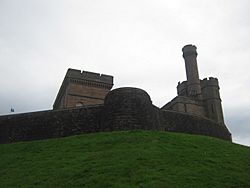Siege of Inverness (1562) facts for kids
Quick facts for kids Siege of Inverness (1562) |
|||||||
|---|---|---|---|---|---|---|---|
| Part of the Scottish clan wars | |||||||
 Inverness Castle in modern times. Some of the old curtain wall can be seen in the foreground, while the castle building itself was rebuilt in 1836 |
|||||||
|
|||||||
| Belligerents | |||||||
| Supporters of Mary, Queen of Scots: Clan Fraser of Lovat Clan Munro |
Supporters of George Gordon, 4th Earl of Huntly: Clan Gordon |
||||||
| Commanders and leaders | |||||||
| William Fraser Robert Munro |
Alexander Gordon | ||||||
| Strength | |||||||
| Unknown | Unknown | ||||||
| Casualties and losses | |||||||
| Unknown | Unknown | ||||||
The Siege of Inverness in 1562 was a short but important event in Scottish history. It happened when Mary, Queen of Scots, visited the town of Inverness. The castle there was controlled by a powerful family, the Gordons.
When Queen Mary arrived on September 9, 1562, the gates of Inverness Castle were closed to her. This was done by Alexander Gordon, who was following orders from his leader, George Gordon, 4th Earl of Huntly. The Earl of Huntly was a very important person in the area. Because the castle refused to let the Queen in, her supporters quickly surrounded it.
Contents
What Happened During the Siege?
The siege of Inverness Castle lasted for three days. The Queen's supporters, including members of Clan Fraser of Lovat and Clan Munro, worked together to take the castle.
The Castle Falls
When the castle was finally captured, Alexander Gordon, who had closed the gates, faced serious consequences for his actions. He was punished for being disloyal to the Queen.
The castle's defenders were a small group, only about 12 to 14 people. Some of them were taken prisoner, while others were allowed to leave.
Queen Mary's Stay
After the castle was taken, Queen Mary stayed there for several nights. She slept at Inverness Castle from September 11 to September 14, 1562. After her stay, she moved on to Spynie Palace.
During her time in Inverness, Queen Mary bought supplies. She purchased gunpowder and 15 tartan plaids for her servants and household members.
Who Helped Queen Mary?
Early records of the siege mention that the Frasers and Munros were key in helping Queen Mary. These clans were loyal to the Queen and helped her take control of Inverness Castle.
Later stories also included the Mackenzies and Rosses as helpers. However, the earliest account, written by George Buchanan, only mentions the Frasers and Munros.
Queen Mary's Spirit During the Conflict
An English diplomat named Thomas Randolph was with Queen Mary during this time. He noted that she was in good spirits and not afraid, even during the conflict.
Queen Mary made a famous remark that showed her brave attitude. When the night watch returned in the morning, she said she wished she was "not a man to know what life it was to lie all night in the fields, or to walk upon the causeway with a jack and knapschall, a Glasgow buckler and a broad sword." This showed her adventurous spirit and her interest in the life of a soldier.
Images for kids


